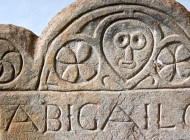By Greg Smith
ONLINE – “It’s time for some clarity around the topic of Confederate monuments and memorials,” Soane Foundation executive director Michael Diaz-Griffith wrote in a social media post June 10. “There is nothing ambiguous about their history, and there are plenty of sensible solutions for removing and/or recontextualizing them.”
What followed was The Anti-Racist Preservationist’s Guide To Confederate Monuments: Their Past And A Future Without Them, a slideshow of ten graphics laying out the unadulterated history of Confederate monuments found around the United States and their meaning both when they were erected – many of them in the Jim Crow era – and into today. Since that posting, the story has been shared widely and made its way into education, government and preservation circles, serving as a jumping off point to answer the difficult question of what should be done with Confederate monuments in the United States.
Diaz-Griffith is from the South.
“Confederate monuments and memorials are a familiar part of the built-in environment and the cultural landscape for me,” he says. “I grew up on ‘Lost Cause’ ideology in North Alabama. I was able to unwrap what I learned from the Civil War and Jim Crow era in my teenage years.”
The format for Diaz-Griffith’s post was intentional. “A clearly laid-out explainer,” he called it, delivering contemporaneous quotes and history in bite-sized and easily digestible images. The post was designed by Abigail Muir and the drawings are by Alonso Diaz Rickards. The post emulates the way digital political messages are currently being spread, by way of memes and short illustrations on social media.
The ten-image post begins with “Lost Cause” ideology, its proponents’ colonization of public spaces and the politics of that day contextualized by the historic opposition to their construction, before bringing it home to present day with a number of solutions provided for the future.
“I started this about two weeks ago when discussion was bubbling up around Monument Avenue in Richmond, and I saw a very polarized discussion about either keeping the monuments in place without any changes or tearing them down,” Diaz-Griffith said. “Preservationists and historians are having very nuanced conversations about the other alternatives that weren’t being explored in these conversations, but I hadn’t seen these encapsulated in any one place.”
Diaz-Griffith said that the history, as told by transcript and contemporaneous writings, is what provides the clearest picture of the ideations and genesis behind these monuments, and what they were intent on memorializing. It is the history that has the power to supersede present day politics.
“If you don’t understand this history and you just see the monuments and memorials as cultural patrimony, it’s difficult to see why they are offensive,” he said.
It becomes important to look at the inscriptions and dedications on the monuments to learn their mission. They were not just dedicated to the dead, some are dedicated to the “Lost Cause” struggle.
“The transcripts from some of the ceremonies were bone-chilling,” Diaz-Griffith said. “In some cases, they used the term ‘white supremacy’ – that was not a term created by opponents, the supporters created it. Some call it ‘Anglo Saxon supremacy,’ some call it ‘Christian supremacy.’ Most of the dedication ceremonies during the Jim Crow era were about dedicating these to that cause and not an individual. The idea that the cause is going to be handed down to a future generation somewhat silently through these monuments is very explicit.”
Conversations about these monuments are happening everywhere as some are toppled and others are voluntarily taken down around the South. The conversations are occurring both socially and professionally, though the topic remains hot among any professionals who care for any property that has a Confederate monument in its possession. Diaz-Griffith said the guide is an excellent jumping off point to unpack the meaning behind the monuments, though he notes there are an unlimited number of ways to tackle the issues.
“The solutions that are mentioned are just a couple of many,” he said. “I wanted to create a document for a broad audience, so I don’t go into all of them. There is nuance.
“One thing that is interesting to our field is that the vast majority of the monuments were mass-produced in the North – in Connecticut and New Jersey. When we’re thinking about the Lee memorial, or other commissioned works of art – whatever you think of their quality or style – they were commissioned for their site. There are few of those when compared to the mass-produced monuments throughout the South. So should we treat them differently?”
That’s just one question Diaz-Griffith raises.
“People in our industry are already thinking about what to do with them as a source of a headache,” he continued. “But I’m receiving messages from thinkers and artists about all of the creative ways they can be used as well. One person might be thinking how to display them in certain settings or if they will destroy a mass-produced example – and it’s a legitimate practice to do that. But artists, especially with the mass-produced examples, could create new installations with them. So many things can happen that we as museum folk or anyone in the preservation trade might not think about if we don’t involve other audiences in the discussion.”
Involving other perspectives in the conversation is paramount, Diaz-Griffith said, and Black people should be given a seat at every table where decision making occurs.
“There are many possible solutions for communities to arrive at. It is a mix of involvement of local community members, the law in cities and states, and funding for removal or recontextualization, as well as what comes next. Recontextualization is a real solution. But we have to confront the physical objects and their true history.”
Since posted, Diaz-Griffith has seen his story make the rounds. “I’ve received lots of messages about how it has been put into official uses: preservation groups, historic houses in the South, town councils, it was brought before a governor. The American Studies department at UVA is going to assign it to their freshmen. I’ve also heard from teachers and administrators in high schools and middle schools that intend to use it.”
Even outside of official channels, the sharing of factually correct history and the dispelling of propaganda is necessary to create an environment of equality.
Said Diaz-Griffith, “I think the conversation that arises out of this confrontation with history can facilitate a healing experience or reconciliatory process in communities with Confederate monuments.”
To learn more, follow Michael Diaz-Griffith on Instagram @michaeldiazgriffith.














